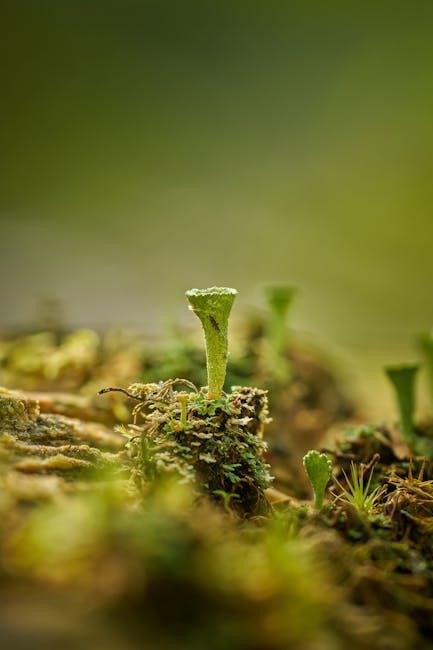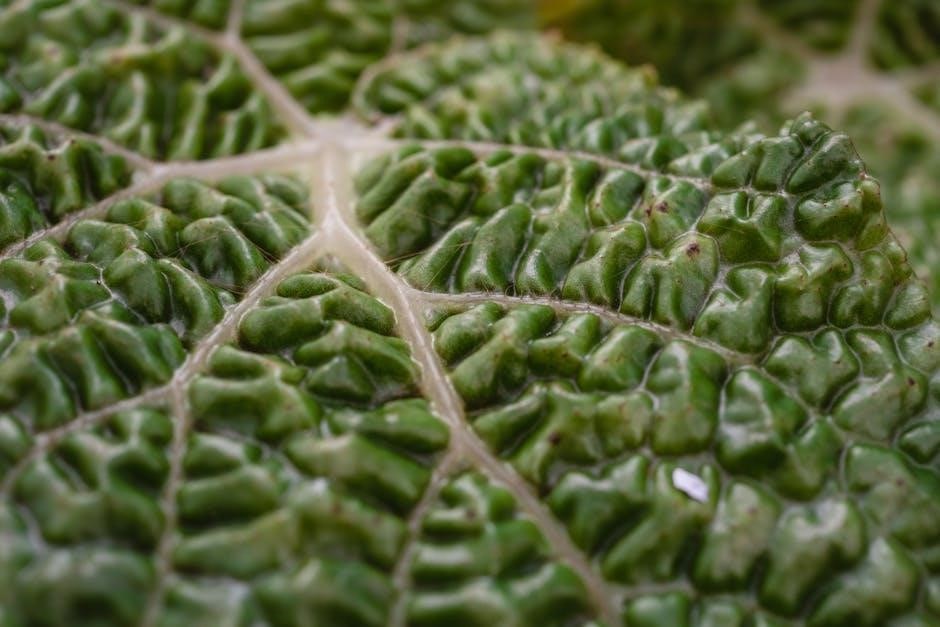
photosynthesis and cellular respiration study guide
Photosynthesis and cellular respiration are fundamental biological processes supporting life on Earth. They facilitate energy conversion, sustain food chains, and regulate Earth’s material cycles, ensuring ecological balance.

What is Photosynthesis?
Photosynthesis is a vital biological process where plants, algae, and some bacteria convert sunlight, carbon dioxide, and water into glucose and oxygen, sustaining life and energy production.
2.1. Definition and Overview
Photosynthesis is a complex, light-driven process by which plants, algae, and certain bacteria convert carbon dioxide and water into glucose and oxygen. It occurs in specialized organelles called chloroplasts and involves two main stages: the light-dependent reactions and the light-independent reactions. The process requires chlorophyll, a green pigment that captures light energy, and is essential for producing energy-rich molecules like ATP and NADPH. This biological process is fundamental for sustaining life on Earth.
2.2. Importance of Photosynthesis
Photosynthesis is vital for life on Earth, providing oxygen and organic compounds essential for food chains. It sustains plant growth, supports herbivores, and indirectly nourishes carnivores. By converting carbon dioxide into oxygen, it regulates Earth’s atmosphere and climate. Additionally, photosynthesis forms the energy foundation for ecosystems, enabling biological processes and maintaining ecological balance. Its significance extends to agriculture, forestry, and environmental health, making it a cornerstone of life support systems.
2.3. Key Components Involved
Photosynthesis involves several critical components, including chlorophyll, chloroplasts, thylakoid membranes, and stomata. Chlorophyll captures light energy, while chloroplasts house the reactions. Thylakoids host the light-dependent reactions, and stomata regulate gas exchange. Water, carbon dioxide, and sunlight are essential reactants. Enzymes and pigments like chlorophyll a and b also play vital roles. These components work together to facilitate energy conversion and organic molecule production, making photosynthesis possible and efficient in plants and some microorganisms.
The Process of Photosynthesis
Photosynthesis is an essential process where plants convert light energy into chemical energy. It occurs in chloroplasts and involves light-dependent and light-independent reactions, producing glucose and oxygen.
3.1. Light-Dependent Reactions
The light-dependent reactions occur in the thylakoid membranes of chloroplasts. Chlorophyll and other pigments absorb light energy, which is converted into ATP and NADPH. Oxygen is released as a byproduct, completing the light-capturing phase essential for photosynthesis.
3.2. Calvin Cycle (Light-Independent Reactions)
The Calvin Cycle occurs in the stroma of chloroplasts and uses ATP and NADPH from the light-dependent reactions. It involves three stages: carbon fixation, reduction, and regeneration of RuBP. Carbon dioxide is fixed into organic molecules, reduced to form glucose, and RuBP is regenerated to sustain the cycle. This process is essential for producing sugars used by plants and, ultimately, by other organisms, making it a critical part of the food chain.
3.3. Overall Equation of Photosynthesis
The overall equation for photosynthesis is: 6CO₂ + 6H₂O + light energy → C₆H₁₂O₆ (glucose) + 6O₂. This equation summarizes the conversion of carbon dioxide and water into glucose and oxygen using sunlight. It highlights the essential inputs (CO₂, H₂O, light) and outputs (glucose, O₂) of photosynthesis, illustrating its role in energy storage and oxygen production, which are vital for life on Earth and the global carbon cycle.

Light-Dependent Reactions
Light-dependent reactions occur in the thylakoid membranes of chloroplasts, converting light energy into ATP and NADPH. They involve water splitting, electron transport, and the capture of light by chlorophyll and pigments.
4.1. Structure of the Thylakoid Membrane
The thylakoid membrane is a folded, lipid bilayer structure within chloroplasts, housing proteins and pigments like chlorophyll. Its surface is studded with complexes for light absorption and electron transport, enabling water splitting and ATP synthesis. The membrane’s folded architecture increases surface area, optimizing light-dependent reactions. Embedded proteins facilitate proton transport and energy conversion, making it a critical site for photosynthesis.
4.2. Role of Chlorophyll and Other Pigments
Chlorophyll, embedded in the thylakoid membrane, absorbs light energy, primarily in the blue and red wavelengths, driving photosynthesis. Accessory pigments like carotenoids and phycobiliproteins broaden the light absorption spectrum, capturing additional wavelengths. These pigments transfer energy to chlorophyll, enhancing efficiency. Chlorophyll’s unique structure allows it to initiate electron transfer, while carotenoids protect the system from oxidative damage, ensuring optimal functioning of the light-dependent reactions.
4.3. Production of ATP and NADPH
In the thylakoid membrane, light energy drives the synthesis of ATP and NADPH through the light-dependent reactions. Water is split, releasing electrons that fuel the formation of ATP via ATP synthase. Simultaneously, chlorophyll transfers energy to NADP+, reducing it to NADPH. These molecules are essential for the Calvin Cycle, providing energy and reducing power to fix carbon dioxide into organic molecules.

Calvin Cycle (Light-Independent Reactions)
The Calvin Cycle uses ATP and NADPH from light reactions to fix CO₂ into glucose, sustaining life by producing energy-rich organic molecules essential for growth and metabolism.
5.1. Fixation of Carbon Dioxide
The Calvin Cycle begins with the fixation of CO₂, where the enzyme RuBisCO catalyzes the reaction of CO₂ with ribulose-1,5-bisphosphate (RuBP), forming a 6-carbon intermediate. This intermediate quickly breaks down into two molecules of 3-phosphoglycerate (PGA). ATP and NADPH from the light reactions are then used to reduce PGA, regenerating RuBP and producing glyceraldehyde-3-phosphate (G3P), which is used to synthesize glucose and other organic molecules.
5.2. Reduction of Carbon Dioxide
In the Calvin Cycle, carbon dioxide is reduced through a series of enzyme-catalyzed reactions. The 3-phosphoglycerate (PGA) molecules, produced during fixation, are reduced to form glyceraldehyde-3-phosphate (G3P) using ATP and NADPH from the light reactions. This step is critical for converting inorganic carbon into organic molecules, ultimately producing glucose and other sugars. The process relies on enzymes like glyceraldehyde-3-phosphate dehydrogenase and ensures the cycle’s continuity by regenerating RuBP.
5.3. Regeneration of RuBP
The regeneration of ribulose-1,5-bisphosphate (RuBP) is essential for the Calvin Cycle to continue. After CO2 fixation, the five-carbon molecule RuBP is regenerated by converting ribulose-5-phosphate (Ru5P) through a series of enzyme-catalyzed reactions. This step ensures the cycle can continuously fix carbon dioxide and produce sugars. The regeneration process is driven by ATP and enzymes like phosphoribulokinase, maintaining the balance of intermediates necessary for efficient carbon fixation.

What is Cellular Respiration?
Cellular respiration is a metabolic process that breaks down glucose to produce ATP, releasing carbon dioxide and water. It involves glycolysis, the Krebs cycle, and oxidative phosphorylation to generate energy from food.
6.1. Definition and Overview
Cellular respiration is a metabolic process that converts glucose and other organic molecules into energy in the form of ATP. It involves the breakdown of these molecules through a series of reactions, releasing energy that is harnessed to produce ATP. This process occurs in cells and is essential for sustaining life, as it powers various cellular functions and activities. Cellular respiration is a critical counterpart to photosynthesis, forming a cycle of energy production and consumption in ecosystems.
6.2. Importance of Cellular Respiration
Cellular respiration is essential for converting glucose into energy (ATP), powering cellular functions and sustaining life. It supports muscle contraction, biosynthesis, and maintaining cellular homeostasis. Additionally, it plays a key role in ecosystems by recycling carbon dioxide, a critical component for photosynthesis, and contributing to the Earth’s carbon cycle. Without cellular respiration, life as we know it would not be possible, making it a vital biological process.
6.3. Key Components Involved
Cellular respiration involves several critical components, including glucose, oxygen, and carbon dioxide. ATP, NADH, and FADH2 serve as energy carriers. Water and enzymes play essential roles, while mitochondria are the primary site of activity. These elements work together to break down glucose, release energy, and produce ATP, ensuring cellular functions are powered efficiently. Understanding these components is vital for grasping how energy is generated and utilized in cells.

The Process of Cellular Respiration
Cellular respiration is a metabolic process converting glucose into energy (ATP) through glycolysis, the Krebs cycle, and the electron transport chain, producing carbon dioxide and water.
7.1. Glycolysis
Glycolysis is the first step in cellular respiration, occurring in the cytoplasm. It breaks down glucose into two pyruvate molecules, generating a small amount of ATP and NADH. This process is universal, occurring in both aerobic and anaerobic conditions, and does not require oxygen. Glycolysis prepares glucose for further oxidation in the Krebs cycle, making it a critical initial phase for energy production in cells.
7.2. Krebs Cycle (Citric Acid Cycle)
The Krebs Cycle, also known as the citric acid cycle, occurs in the mitochondrial matrix. It oxidizes acetyl-CoA, producing carbon dioxide, ATP, NADH, and FADH2. This cycle is a key metabolic pathway that generates energy-rich molecules for the electron transport chain. It is a central hub for cellular respiration, linking glycolysis to oxidative phosphorylation and sustaining energy production in cells.
7.3. Electron Transport Chain and Oxidative Phosphorylation
The electron transport chain (ETC) and oxidative phosphorylation occur in the mitochondrial inner membrane. They utilize NADH and FADH2 to generate ATP through proton pumping and ATP synthase. The ETC creates a proton gradient, driving the production of ATP during oxidative phosphorylation. This process is the primary source of ATP in aerobic respiration, converting chemical energy into usable cellular energy efficiently.
7.4. Overall Equation of Cellular Respiration
Cellular respiration’s overall equation is: C₆H₁₂O₆ + 6O₂ → 6CO₂ + 6H₂O + ATP (net 36-38 ATP). This equation summarizes the breakdown of glucose into carbon dioxide and water, releasing energy stored in ATP. It represents the combined steps of glycolysis, the Krebs cycle, and oxidative phosphorylation, illustrating the conversion of chemical energy into usable cellular energy.

Aerobic vs. Anaerobic Respiration
Aerobic respiration uses oxygen to generate ATP efficiently, while anaerobic respiration produces less ATP without oxygen, often yielding lactic acid or ethanol.
8.1. Aerobic Respiration
Aerobic respiration is a metabolic process requiring oxygen to convert glucose into ATP. It occurs in mitochondria, involving glycolysis, the Krebs cycle, and the electron transport chain. This process efficiently produces 36-38 ATP molecules per glucose molecule, making it the primary energy source for aerobic organisms. Oxygen acts as the final electron acceptor, enabling the generation of a high-energy yield. It is crucial for sustaining life in oxygen-rich environments.
8.2. Anaerobic Respiration
Anaerobic respiration occurs without oxygen and is less efficient than aerobic respiration. It takes place in the cytoplasm and, in some organisms, in mitochondria. This process converts glucose into ATP, producing lactic acid in animals or ethanol and carbon dioxide in yeast. Anaerobic respiration yields only 2 ATP per glucose molecule, making it a survival mechanism for oxygen-deprived conditions. It is vital in muscle cells during intense activity and in fermentation processes.
8.3. Key Differences
The key differences between aerobic and anaerobic respiration lie in oxygen usage, ATP production, and byproducts. Aerobic respiration requires oxygen, produces 36-38 ATP, and releases carbon dioxide and water. Anaerobic respiration occurs without oxygen, yields only 2 ATP, and produces lactic acid or ethanol and carbon dioxide. Aerobic respiration is more efficient and occurs in mitochondria, while anaerobic respiration happens in the cytoplasm, serving as a backup energy source when oxygen is scarce.
Comparison Between Photosynthesis and Cellular Respiration
Photosynthesis and cellular respiration are interdependent processes. Photosynthesis converts light energy into chemical energy, while cellular respiration breaks it down, sustaining life and energy cycles in ecosystems.
9.1. Similarities
Photosynthesis and cellular respiration share key similarities. Both involve energy transformation, producing and consuming ATP and NADPH. They both require glucose and release or use oxygen and carbon dioxide. Both processes involve electron transfer chains and occur in specific organelles, chloroplasts for photosynthesis and mitochondria for respiration. They are essential for life, supporting energy needs and carbon cycling in ecosystems. Understanding these similarities highlights their interdependence in sustaining life and energy balance.
9.2. Differences
Photosynthesis and cellular respiration differ fundamentally in purpose and processes. Photosynthesis captures sunlight to produce glucose, while cellular respiration breaks down glucose to release energy. Photosynthesis occurs in chloroplasts, relying on light, water, and CO2, and releases oxygen. Cellular respiration occurs in mitochondria, using glucose and oxygen to produce CO2, water, and ATP. Photosynthesis is anabolic, building molecules, whereas respiration is catabolic, breaking them down. Their reactions and energy flows are opposites, yet interconnected.

Where Do These Processes Occur?
Photosynthesis occurs in the chloroplasts of plant cells, while cellular respiration primarily takes place in the mitochondria of most living cells.
10.1. Photosynthesis in Plants
Photosynthesis occurs in plant chloroplasts, where light is captured and converted into chemical energy. The thylakoid membranes host the light-dependent reactions, while the Calvin cycle takes place in the stroma. Chlorophyll plays a central role in absorbing light energy, enabling the conversion of CO₂ and water into glucose and oxygen. This process is essential for plant growth and energy production, supporting life across ecosystems.
10.2. Cellular Respiration in Cells
Cellular respiration occurs in the mitochondria of eukaryotic cells, with glycolysis taking place in the cytoplasm. It involves the breakdown of glucose to produce ATP, releasing carbon dioxide and water. This process is vital for energy production, supporting cellular functions and maintaining life. It is a continuous, highly regulated process essential for the survival of nearly all living organisms, converting biochemical energy into usable ATP.
Ecological Importance
Photosynthesis and cellular respiration are vital for maintaining ecological balance, regulating Earth’s atmosphere, and sustaining life. They drive energy flow, support food webs, and stabilize ecosystems.
11.1. Role in Ecosystems
Photosynthesis and cellular respiration play a central role in ecosystems by driving energy flow and nutrient cycling; Photosynthesis produces oxygen and organic molecules, forming the base of food webs. Cellular respiration breaks down these molecules, releasing energy and CO₂, which plants reuse. Together, they sustain biodiversity, regulate atmospheric gases, and maintain ecological balance, ensuring the survival of all living organisms in an interconnected system.
11.2. Impact on the Environment
Photosynthesis and cellular respiration significantly influence environmental balance. Photosynthesis reduces CO₂ levels by converting it into oxygen, mitigating climate change. Conversely, cellular respiration releases CO₂, contributing to greenhouse effects. Deforestation decreases photosynthesis, disrupting carbon cycles, while excessive respiration accelerates global warming. These processes regulate Earth’s atmosphere, ensuring oxygen availability and temperature stability, thus protecting biodiversity and maintaining ecological health.

Molecular Intermediates
Molecular intermediates like ATP, NADPH, and oxygen are crucial in energy metabolism, bridging photosynthesis and cellular respiration by storing and transferring energy efficiently within cells.
12.1; ATP, NADPH, and Oxygen
ATP, NADPH, and oxygen are essential molecular intermediates in energy metabolism. ATP is a short-term energy storage molecule, while NADPH is a reducing agent. Oxygen is a byproduct of photosynthesis and a critical electron acceptor in cellular respiration. These molecules play central roles in linking light-dependent and light-independent reactions in photosynthesis and the stages of cellular respiration, enabling energy transfer and storage within cells.
12.2. Glucose and Other Sugars
Glucose is a critical intermediate in both photosynthesis and cellular respiration. In photosynthesis, it is synthesized during the Calvin cycle as a stable energy-rich molecule. Conversely, in cellular respiration, glucose is broken down in glycolysis to produce energy. Other sugars, such as fructose and sucrose, also play roles in energy storage and transport, particularly in plants. These molecules are vital for energy exchange and metabolic processes in living organisms.
Applications in Agriculture and Industry
Understanding photosynthesis and cellular respiration informs techniques to enhance crop yields, optimize resource use, and develop sustainable industrial processes, benefiting both agriculture and biotechnology sectors.
13.1. Maximizing Crop Yield
Optimizing photosynthesis enhances crop yields by improving light absorption, CO2 utilization, and RuBP regeneration. Farmers adjust light intensity, temperature, and water supply to boost efficiency. Understanding the Calvin cycle aids in developing crops with enhanced photosynthetic pathways, increasing biomass production. Selective breeding and genetic modifications further maximize yields, ensuring food security and sustainable agriculture. These practices directly impact global food production, making photosynthesis a cornerstone of agricultural productivity.
13.2. Biotechnological Applications
Photosynthesis and cellular respiration inspire biotechnological innovations. Engineered microorganisms optimize biofuel production, while artificial photosynthesis mimics light reactions to create clean energy. Genetic modifications enhance crop resilience and yield. Bioremediation leverages cellular respiration to degrade pollutants, promoting environmental cleanup. These advancements showcase the potential of biological processes to address global challenges, fostering sustainable solutions across industries.

Study Tips for Mastery
Mastering photosynthesis and cellular respiration requires understanding core concepts, creating detailed diagrams, and practicing past exam questions. Focus on key processes and interconnections to excel.
14.1. Key Concepts to Focus On
To master photosynthesis and cellular respiration, focus on understanding the light-dependent and light-independent reactions, the Calvin Cycle, glycolysis, the Krebs Cycle, and the electron transport chain. Memorize the overall equations and the roles of ATP, NADPH, and oxygen. Pay attention to how these processes interconnect and contrast. Understanding the differences between aerobic and anaerobic respiration is also crucial. Diagrams and concept maps can help visualize these complex pathways effectively.
14.2. Practice Questions and Past Papers
Engaging with practice questions and past papers is essential for reinforcing concepts. Work through multiple-choice questions, essay prompts, and diagram-based problems to test your understanding. Past papers provide insight into exam formats and common topics. Time yourself to improve exam readiness. Analyze incorrect answers to identify weak areas and review corresponding study material. Regular practice builds confidence and mastery of photosynthesis and cellular respiration.